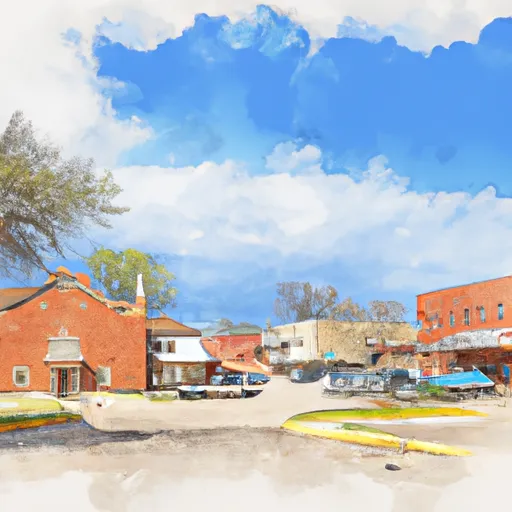-
 Snoflo Premium
Snoflo Premium
Get unlimited access to all our content
With no Ad interruptions! - Start Your Free Trial Login with existing account
Mc-Louth
Eden Index
Climate
8.3
•
Recreation
2.8
•
Community
2.7
•
Safeguard
5.0/10

McLouth, Kansas is a small town located in Jefferson County. The climate in McLouth is characterized by warm summers and cold winters, with average temperatures ranging from the 20s to the 90s Fahrenheit. The area experiences moderate precipitation throughout the year, with snowfall occurring during the winter months. The hydrology constituents of McLouth are primarily influenced by the nearby Delaware River, which flows through the town. The river provides opportunities for water-based activities such as boating, fishing, and kayaking.
In terms of outdoor recreation, McLouth offers various opportunities for nature enthusiasts. Perry Lake, located just north of the town, is a popular destination for boating, swimming, camping, and hiking. The lake boasts numerous trails that wind through scenic forests, offering breathtaking views of the surrounding landscapes. Additionally, the Perry State Park, adjacent to the lake, provides facilities for picnicking and wildlife watching. McLouth is also surrounded by vast farmlands and open spaces, making it an ideal location for outdoor activities such as bird watching, hunting, and nature photography. With its pleasant climate, picturesque waterways, and ample outdoor recreational opportunities, McLouth attracts visitors and locals alike who appreciate the beauty of nature.
What is the Eden Index?
The Snoflo Eden Index serves as a comprehensive rating system for regions, evaluating their desirability through a holistic assessment of climate health, outdoor recreation opportunities, and natural disaster risk, acknowledging the profound impact of these factors on livability and well-being.
Climate Health Indicator (CHI): 8.3
Mc-Louth receives approximately
967mm of rain per year,
with humidity levels near 81%
and air temperatures averaging around
13°C.
Mc-Louth has a plant hardyness factor of
6, meaning
plants and agriculture in this region thrive during a short period during spring and early summer. Most
plants will die off during the colder winter months.
By considering the ideal temperature range, reliable water supplies, clean air, and stable seasonal rain or snowpacks, the Climate Health Indicator (CHI) underscores the significance of a healthy climate as the foundation for quality living.
A healthy climate is paramount for ensuring a high quality of life and livability in a region, fostering both physical well-being and environmental harmony. This can be characterized by ideal temperatures, reliable access to water supplies, clean air, and consistent seasonal rain or snowpacks.
Weather Forecast
Streamflow Conditions
Kansas
Area Rivers
Kansas
Snowpack Depths
Kansas
Reservoir Storage Capacity
Kansas
Groundwater Levels
Recreational Opportunity Index (ROI): 2.8
The Recreational Opportunity Index (ROI) recognizes the value of outdoor recreational options, such as parks, hiking trails, camping sites, and fishing spots, while acknowledging that climate plays a pivotal role in ensuring the comfort and consistency of these experiences.
Access to outdoor recreational opportunities, encompassing activities such as parks, hiking, camping, and fishing, is crucial for overall well-being, and the climate plays a pivotal role in enabling and enhancing these experiences, ensuring that individuals can engage in nature-based activities comfortably and consistently.
Camping Areas
| Campground | Campsites | Reservations | Toilets | Showers | Elevation |
|---|---|---|---|---|---|
| Kamp Siesta | None | 893 ft | |||
| Danny Elliott Park | 4 | 812 ft | |||
| Idle Hour Lake | 20 | 907 ft | |||
| Marvel Park | 12 | 870 ft | |||
| Elmore Park | None | 805 ft | |||
| Osawatomie City Lake | 6 | 892 ft | |||
| East River Park | None | 790 ft | |||
| Louie P. Gartner RA | 9 | 905 ft | |||
| South Lake Veterans Memorial Park - Garnett | 5 | 1,026 ft | |||
| Lake Garnett City Park | None | 1,035 ft |
Nearby Fishing
Catastrophe Safeguard Index (CSI):
The Catastrophe Safeguard Index (CSI) recognizes that natural disaster risk, encompassing floods, fires, hurricanes, and tornadoes, can drastically affect safety and the overall appeal of an area.
The level of natural disaster risk in a region significantly affects safety and the overall livability, with climate change amplifying these risks by potentially increasing the frequency and intensity of events like floods, fires, hurricanes, and tornadoes, thereby posing substantial challenges to community resilience and well-being.
Community Resilience Indicator (CRI): 2.7
The Community Resilience Indicator (CRI) recognizes that education, healthcare, and socioeconomics are crucial to the well-being of a region. The CRI acknowledges the profound impact of these elements on residents' overall quality of life. By evaluating educational resources, healthcare accessibility, and economic inclusivity, the index captures the essential aspects that contribute to a thriving community, fostering resident satisfaction, equity, and social cohesion.

